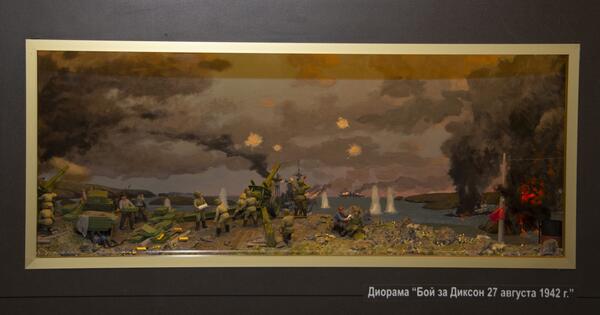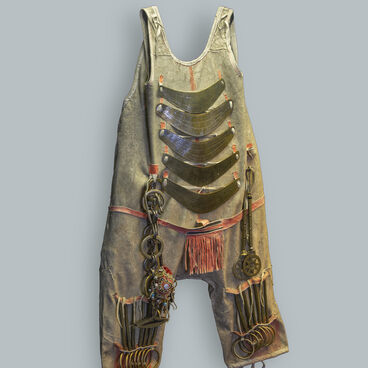Andrey Kimovich Dorogin, a member of the Union of Artists, graduated from the Higher Art and Technical School named after V. I. Mukhina in 1978 with a degree in Industrial Art. He is known as the author of the dioramas that were included in the collections of Soviet and Russian museums.
This work is dedicated to the battle for Dikson that took place on the night of 26 to 27 August, 1942.
Port Dikson was deep in the rear, but played an important role in wartime: it was there that caravans carrying food, raw materials for factories, and other valuable cargoes passed. In order to intercept the convoy ships, the Germans planned Operation Wunderland (“Wonderland”). The plans involved destroying the radio station of the Western Arctic Marine Headquarters, capturing prisoners and valuable documents — maps and information about the ice situation.
In the summer of 1942, on the order of the People’s Commissar of the Navy, Nikolay Gerasimovich Kuznetsov, a detachment of artillery assemblers arrived at the port of Dickson to dismantle the batteries and transport them to Novaya Zemlya. On 25 August, the icebreaker Dezhnev arrived to collect the guns.
On the same day, Dikson received information from the icebreaker Alexander Sibiryakov about an enemy ship sighted near Belukha Island. When the German cruiser approached the island, the sailors and polar explorers were ready to attack. The icebreakers Dezhnev and Revolutionary sailed forward to face the enemy. There were not enough forces to repel enemy fire, but in the meantime, the transport vessel Kara, carrying explosives for the mines of the Norilsk plant, managed to get to safety. The attack lasted 23 minutes.
An hour and a half later a second one began, from a different direction, but it was countered by a coastal battery under the command of Nikolay Mikhailovich Kornyakov. The 152-mm gun opened fire; the first shot threw the gun backward so that the spades went under the rail supports. The second gun was backed by a coal heap and a tracked tractor. All that time Nikolay Kornyakov and sergeant Ivan Saulyak, the gun commander, who had been wounded by shrapnel, did not leave the battle site.
After some time, the enemy, having sustained serious damage, turned around and withdrew from the Vega Strait into the Kara Sea.
None of the tasks assigned to “Wonderland” could be accomplished. The Soviet cargo ships continued on their routes.
This work is dedicated to the battle for Dikson that took place on the night of 26 to 27 August, 1942.
Port Dikson was deep in the rear, but played an important role in wartime: it was there that caravans carrying food, raw materials for factories, and other valuable cargoes passed. In order to intercept the convoy ships, the Germans planned Operation Wunderland (“Wonderland”). The plans involved destroying the radio station of the Western Arctic Marine Headquarters, capturing prisoners and valuable documents — maps and information about the ice situation.
In the summer of 1942, on the order of the People’s Commissar of the Navy, Nikolay Gerasimovich Kuznetsov, a detachment of artillery assemblers arrived at the port of Dickson to dismantle the batteries and transport them to Novaya Zemlya. On 25 August, the icebreaker Dezhnev arrived to collect the guns.
On the same day, Dikson received information from the icebreaker Alexander Sibiryakov about an enemy ship sighted near Belukha Island. When the German cruiser approached the island, the sailors and polar explorers were ready to attack. The icebreakers Dezhnev and Revolutionary sailed forward to face the enemy. There were not enough forces to repel enemy fire, but in the meantime, the transport vessel Kara, carrying explosives for the mines of the Norilsk plant, managed to get to safety. The attack lasted 23 minutes.
An hour and a half later a second one began, from a different direction, but it was countered by a coastal battery under the command of Nikolay Mikhailovich Kornyakov. The 152-mm gun opened fire; the first shot threw the gun backward so that the spades went under the rail supports. The second gun was backed by a coal heap and a tracked tractor. All that time Nikolay Kornyakov and sergeant Ivan Saulyak, the gun commander, who had been wounded by shrapnel, did not leave the battle site.
After some time, the enemy, having sustained serious damage, turned around and withdrew from the Vega Strait into the Kara Sea.
None of the tasks assigned to “Wonderland” could be accomplished. The Soviet cargo ships continued on their routes.






